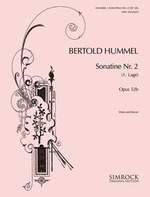Sonatina No. 2 for Violoncello and Piano, op. 52a (1973)

I.
Allegro maestoso ![]() Version
for viola
Version
for viola
II. Andante cantabile
III. Finale-Toccata
Dedication: for Cornelius
Duration: 6 Minutes
Publisher:
N. Simrock Hamburg-London (Boosey & Hawkes) EE 2953 / ISMN: 979-0-2211-0854-8
| I. | II. | III. |
Press
PTM Inter Music, August 1979
Easy concert music for cello and piano is rather difficult to come by, so it was good to see Sonatina No. 2 (1973) by Bertold Hummel published by Simrock. The entire work restricts the cello to the first position, so it is an ideal first concert-piece. The work opens with a cut common Allegro Maestoso in C. The gentle Andante Cantabile leads to an exiting Finale-Toccata, also in C. This really is a splendid work, and will surely become an established favourite.
STRINGS/USA
Feb.1991
It is no surprise
to discover that composer Bertold Hummel trained as a cellist as well as a composer.
He writes with an intimate knowledge of strings, and seems to favor the lower
sound of viola and cello. His special talent is for composing pieces which are
full of variety and vitality, but technically easy enough for capable students.
These pieces will delight teachers and students who are looking for accessible
contemporary music.
Hummel is at his best in pieces such as the Sonatina
No. 1, op. 35, originally written in 1969 for violin and piano, and also
available in arrangements for viola and piano, and cello and piano. The strong
rhythms and hold harmonies of the first movement contrast with the second movement,
an elegy played con sordino. The lively last movement alternates an alla breve
time signature with 3/4 time. The piano part supplies a good deal of musical interest,
and the piece is always musically gratifying.
The Sonatina No. 2
for cello and piano is another piece in Hummel's varied, economical style. Like
the Sonatina No. 1, this piece is made up of three contrasting movements,
with a slow middle movement. The entire cello part can be played in the first
position. However, the piano part, although well-balanced with the cello part,
is far from easy, and the effect is somewhat reminiscent of the Three Easy
Pieces by Hindemith. The Little Suite, for cello and piano,
and the short but effective Arioso for cello and piano, from 1986,
round out Hummel's significant contribution to the literature for cello and piano.
Although many of Hummel's pieces for solo stringed instrument and piano are clearly
intended for students, I would
not hesitate to place them on a recital program.
Their beauty and excitement could not fail to please an audience.
(D.M.
B.)